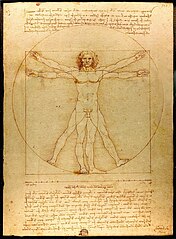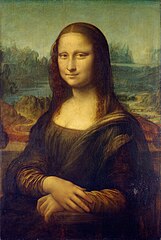
Leonardo Da Vinci was one of the most prominent figures of the renaissance age. He was not only a great painter but he had also left a legacy of art, thoughts, and science, which continues to inspire people all over the world. After the book "The Da Vinci Code" by Dan Brown was published in 2003, most of the famous paintings by Leonardo Da Vinci came under the spotlight. Before this event, people used to admire his great paintings but after this they started to look at his paintings in a new manner. They started to look for hidden secrets buried in his paintings. It is believed that he was a member of some secret societies like, Priory of Sion, freemasonry, and The Knights Templar. He was an enlightened man of his period and had immense knowledge, for this, many times in his life he came close to being burned at the stake, especially for his esoteric works. This might be the reason that he had hidden decipherable codes in his most famous paintings, so that it can be deciphered in the future. These codes are not fictitious, they contain some secret knowledge and if deciphered, may change the whole perception of mankind. Some of his most famous paintings with hidden clues are:
1. The Last Supper

This painting is one of the most popular paintings by Leonardo Da Vinci. The theme of this painting is the last supper, Jesus Christ had with his 12 disciples before one of his disciples betrayed him. He completed this mural between 1494 and 1498. This painting contains many controversial secret codes. If these codes are proved right, then it will shake the whole foundation of mankind.
a. According to the Gospels, Jesus Christ attended the last supper with his 12 disciples but if you look at this painting, you can find a feminine figure sitting besides Jesus. There was only one woman present during the last supper and she was Mary Magdalene but according to the Bible she just wiped Jesus's feet and had no role in the supper. Then why did Da Vinci portrayed Magdalene besides Jesus? This only leads to one answer that Jesus was married to Magdalene but there is nothing written about this in the Bible or this omission was made knowingly, only the future can tell.
b. There is also a confusion among art historians about who is holding the knife in this painting? It is argued that it may be the hand of Mary, Peter, or even John, who is missing from this painting. Most of the conclusions point to Peter because he is angry, when Jesus Christ tells them that one of them will betray him.
c. Leonardo Da Vinci was adept in many techniques and one of them was "mirror writing." When scholars placed an mirrored version of this painting over its original version, the images of two Templar Knights appeared, standing at both ends of the table. There was also an image of a person standing between Jesus and Magdalene holding an infant. Many scholars believe that it is the child of Jesus Christ and Mary Magdalene.
d. The latest code to be deciphered from this painting is that, some art historians believe that Da Vinci portrayed himself in this painting. They believe that he used his own face to portray two of the disciples in this painting.
2. Mary Magdalene

This painting was recently discovered. Many art scholars attributed this painting as a masterpiece of Da Vinci. Some scholars don't agree with this notion but the fact is this painting clearly shows Da Vinci's style and technique. This is a semi naked painting of Magdalene but that doesn't make it unique. The unique quality of this painting is the similarity in face of Magdalene in this painting and in the painting of the Last Supper. This identical similarity concretes the notion that the woman sitting to the right of Jesus Christ in The Last Supper is really Mary Magdalene.
3. The Vitruvian Man

This is literally the most complex drawing in the history of mankind. This symbol is now used by medical professionals as well as medical establishments. This drawing was created by Da Vinci around the year 1487. He was the only artist who succeeded in depicting the perfect man of Marcus Vitruvius. It shows a male figure perfectly inscribed in a circle and a square in two different positions. This drawing represents the perfect proportions of a man on the basis of geometry.
a. If we study this drawing according to the Pythagorean tradition, then the circle represents the spirit and the square represents the material existence and thus human body represented the combination of both spirit and matter.The concept behind this drawing was that the human body is a scaled down version of the whole world and the cosmos in it.
b. Some art scholars also believe that the body at the center of this geometry is Christ's body and thus making an intersection between human and the divine. If we examine this drawing at different angles, we can find many hidden Masonic symbols in it.
c. In this drawing you will find many numbers and symbols which are geometrical in nature but they are also part of religions like Christianity, Hinduism, and Islam. The proportions of man are so perfect in this drawing that it leads to the fact that geometry is actually associated with the whole concept of evolution of life on Earth. You can see the work of this proportion in each and every aspect of your life.
d. This complex drawing is not fully solved till now and this leads to the notion that geometry is definitely related with forbidden knowledge.
4. Mona Lisa

This is the most popular Da Vinci painting that has been a topic of debate from the very first time it was created. This is the only painting in the world that is visited by more than 6 million people in a year.He started worked on this painting in 1503 and it took at least 4 years to complete it. People all the over world debated over a million theories to find the secret hidden in Mona Lisa. The two main mysteries regarding this painting is the identity of the woman and why she is smiling? Da Vinci had never mentioned anything about this woman in his notes.
a. Many questions were raised about the real identity of this women, everybody had different answers. The people from Italy and French called her with different names. Most of the art historians believe that she is Lisa del Giocondo, the wife of a wealthy silk merchant named Fransesco del Giocondo. It is believed that Da Vinci painted this for her husband. The real identity of her is still hidden.
b. When everybody though that the puzzle was solved, another riddle came up. The new theory is that the woman in this painting is not an woman but a self portrait of Da Vinci himself.
c. Da Vinci used a painting technique called "sfumato" in Mona Lisa. This technique creates a blurry and cloudy painting, thus the interpretation of the painting depends on the viewers imagination. If you directly look at the lips of Mona Lisa, you will not find her smiling but when you look at her whole face, you can see the mysterious smile. The appearance and disappearance of her smile depends on the viewers vision and imagination. This technique is the reason behind the mysterious smile of Mona Lisa.
d. If Mona Lisa is really a self portrait of Da Vinci himself, then it explains why he is smiling. He did know that it would take years for us to solve this riddle and it really took more than 500 years to solve it.
Leonardo Da VInci had once said,"There are three classes of people: Those who see. Those who see when they are shown and those who do not see." If we really want to decipher his codes, then we have to see what others can't see or don't want to see.
The images used in this articles are from wikimedia.